Star Wars Galaxies: An Empire Divided, often simply referred to as Star Wars Galaxies or abbreviated SWG, was a Star Wars–themed MMORPG developed by Sony Online Entertainment (SOE) and published by LucasArts for Microsoft Windows PCs. The base game was released on June 26, 2003 in the United States of America, November 7, 2003 in Europe, December 23, 2004 in Japan, and in 2006 in Australia. The base game was upgraded with three major expansions since. In addition to the initial cost of the game software, SOE charged a monthly subscription fee (like most other MMORPGs) of $14.99 USD (€11.15, £9.49), with discounts for 3-, 6-, and 12-month subscriptions. On June 24, 2011, Sony announced that Galaxies would be shut down on December 15 of that year.
On March 16, 2000, LucasArts Entertainment announced a partnership with Verant Interactive Inc. and Sony Online Entertainment (SOE) to create the first massively multiplayer Star Wars online role-playing game. The then-unnamed game would be developed by Verant with online play supported by SOE. This was the same team that created and supported the popular Everquest massively multiplayer online game. LucasArts would be responsible for all distribution of the Star Wars online game. The announcement included an expected release date sometime in 2001 and that the game would take place during the classic trilogy Star Wars era.
LucasArts officially announced the brand name of the game to be Star Wars Galaxies on November 29, 2000. The announcement claimed the first round of testing for Star Wars Galaxies was expected to start in late 2001, which would push back the official release date to an unknown time. The game's official information site was launched on November 30, 2000 in conjunction with SOE and featured frequently asked questions about the game and message boards fielded by members of the development team.
On May 17, 2001, even before the game went into public beta testing, the first expansion's development was announced. The yet-unnamed add-on, which was expected to be available six months after the initial product release, would be a space simulation and enable players to own and fly starships which would allow interplanetary travel and space combat. The release date of the initial product, the ground-based component, was updated to the second half of 2002. The staggered release schedule of the space component of the Star Wars Galaxies series was said to benefit players because they would have time to establish their characters and explore different elements of the core game before adding the space layer. Traveling between planets would be accomplished through the use of public shuttles, which would ferry characters from world to world.
A new official site launched on the same day, which placed more of an emphasis on the community of the game. It included new screen shots, movies, an updated FAQ, concept art, development team members' profiles, features about the game, and a new forum. The site reached 100,000 users by December 2001. Throughout the next year after the release of the site, new content would be revealed. This content included information on species and locations, new images and movies of different game elements, and 360-degree QuickTime VR panoramas of different locations.
In May 2002, Verant began accepting applications from users who were interested in participating in a closed beta test for Galaxies. The closed beta test would begin in July 2002. SOE would share more information on the game as the beta moved forward. This would include more screen shots, information on match making services, the fact that players would be permitted only one character per server, and skill trees and how the skill-based system would function. LucasArts also announced on May 20, 2002 that both the Xbox and PlayStation 2 would get a version of the game, but these would later be cancelled.
The year 2002 ended with LucasArts officially confirming a release date of April 15, 2003. They also announced on December 20, 2002 that the ground-based component of Star Wars Galaxies would be called An Empire Divided and that the game's online community had grown to over 400,000 users since its original release in November 2000. This represented one of the largest ever fan communities amassed for any game prior to retail availability.
An Empire Divided would later be delayed to an unknown time, but on June 17, 2003, LucasArts confirmed that Star Wars Galaxies: An Empire Divided would be released on June 26.
With a Star Wars license and veteran designer Raph Koster at the helm, expectations among gamers ran high during the development of Galaxies. Many industry professionals expected that these forces would push the subscription numbers past the one million mark. As development wore on, the release date was pushed back, features were cut, and Sony canceled planned ports for the Xbox and PlayStation 2.
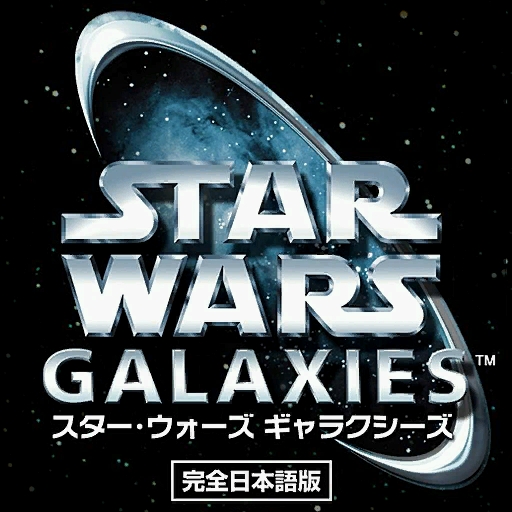
The logo used for the Japanese localization
The base game, An Empire Divided, was released in the United States on June 26, 2003 to mixed reviews. Galaxies was most criticized for numerous bugs and broken features that plagued the game. After release, the developers continued working on the features cut during the delay. In November 2003, two of those most anticipated features, creature mounts and player-created cities were enabled. Also, on November 7, 2003 it was announced that the first player had unlocked a Force-sensitive character slot needed to become a Jedi.
On November 7, 2003, An Empire Divided was released in Europe. A localized version for the Japanese market was published by Electronic Arts Japan on December 23, 2004. However, Japanese acceptance of the game was low, and in November 2005 the servers were shut down and existing accounts migrated to US servers.
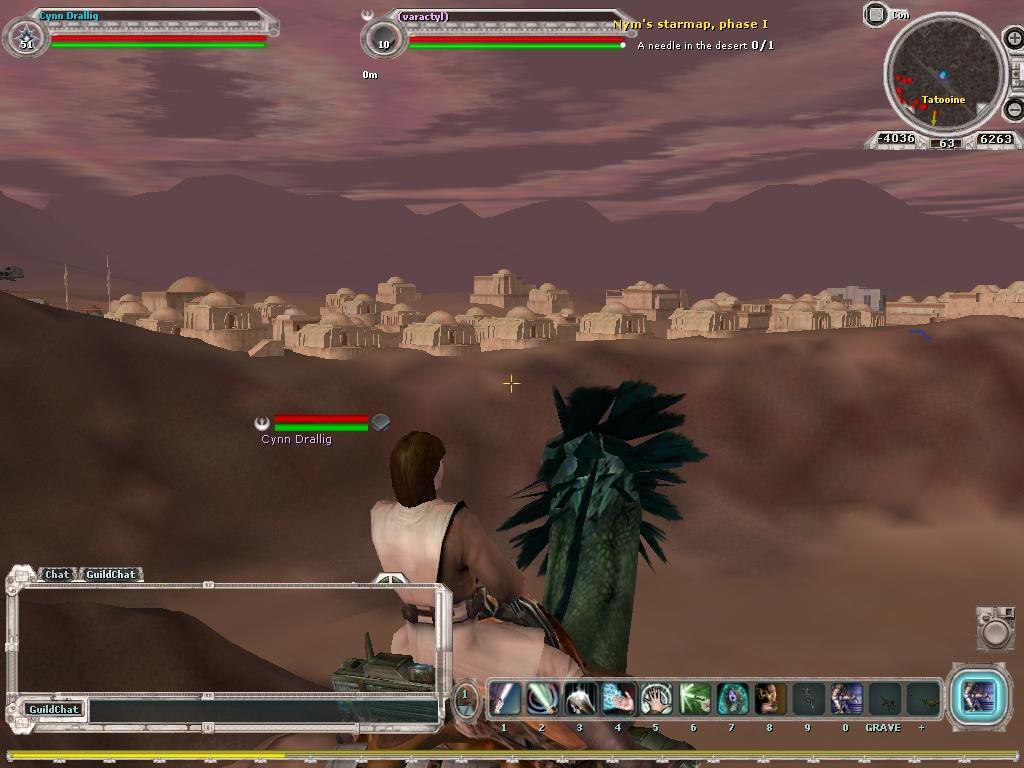
A small town on Tatooine
Star Wars Galaxies did not begin with any sort of overarching story. Originally, as the original opening crawl states, after character creation, the player started out on an Imperial Star Destroyer after being captured on a passenger ship suspected of illegal activity. After being cleared of any wrongdoing, the player was instructed to make their way through the ship towards the shuttle bay. Along the way, various obstacles were used to educate the player in the basics of game play. After reaching the shuttle bay, the player was allowed to choose a starting planet, then city. The planetary choices were Naboo, Tatooine, or Corellia. A majority of the already established cities on the planet of choice could be chosen as a starting point, such as Moenia, Theed, Coronet, Doaba Guerfel, Mos Eisley, or Anchorhead. After choosing, they were loaded up into their city of choice on the planet with nothing but a green and yellow R2 helper droid, a limited-use 74-Z speeder bike and no real direction on what to do next.
After the release of the New Game Enhancements in late 2005, however, story elements became more important to the development of your character. The introductory sequence was changed. This time the player started out on an Imperial space station. The player was quickly contacted by C-3PO, who familiarized the player with the basics of the controls, and informed them that Han Solo would arrive shortly to rescue them. Han, Chewbacca, and R2-D2 arrived and escorted the player to the hangar bay, where they were attacked by three stormtroopers. After killing the troopers, Han, the player and crew boarded the Millennium Falcon and escaped the exploding station, with TIE fighters giving chase. The next sequence was meant to familiarize the player with the space-combat game play. The player commanded one of the Falcons turrets and destroyed several TIE fighters, after which the Millennium Falcon hyperjumped to Tansarii Point Station. After arriving on the station, the player was free to complete several story-driven quests on their quest for credits and experience (the player had to reach level 5 before they could leave the station). Once the player was sufficiently experienced, the player had to aid Han Solo in repairing the Falcon. Upon doing so, Han Solo dropped the player off in front of the spaceport in Mos Eisley on Tatooine. Before leaving, Han Solo set them up with a speeder, and a contact in Mos Eisley. This led the player to working for Jabba the Hutt, first through Bib Fortuna, then directly from Jabba's Palace. Further quests in this overarching chain (known collectively as the Legacy quests) took the player to other planets, including Naboo, Corellia, and Talus. All throughout this quest chain, the player met many familiar faces from Star Wars lore, including Watto, Ephant Mon, Jabba the Hutt, Boss Nass, and Quarsh Panaka, just to name a few.
From its release in June of 2003 until November of 2005, Star Wars Galaxies used an opening crawl much like the movies as an introduction during character creation. After the release of the New Game Enhancements in November of 2005, a slightly updated opening crawl was used.
- Cries of Alderaan
- Secrets of the Syren
- Rebel Theme Park
- Imperial Theme Park
- Legacy
- Death Troopers
- Nym's Theme Park
According to the opening crawl of the game, Star Wars Galaxies was set sometime after Episode IV. Meanwhile, the existence of certain characters and quests indicated that the game was set before the events of Episode V.
Serji-X Arrogantus appeared in the game, and is established to have died in 0 ABY. This seemingly implies that Star Wars Galaxies was set very shortly after the Battle of Yavin. However, another character named Sergeant Ruwan Tokai clearly mentioned that the destruction of the Death Star occurred a year earlier, suggesting a timeline closer to 1 ABY. Furthermore, Darth Vader just learns that it was his son, Luke Skywalker, who destroyed the Death Star, a revelation which is said to have occurred around 2 ABY. Cryptic mentions were made in the game about the existence of Echo Base on Hoth. Han Solo's appearance on Lok proves that the game was set before the events of 3 ABY, when he became encased in carbonite. This means certain portions of the game took place immediately after the Battle of Yavin in 0 ABY, some immediately before the Battle of Hoth in 3 ABY, and some in between, making a concrete date impossible to determine for the game as a whole.
With Chapter 11 in November 2008, the developers added the Battle of Hoth to the game. However, the developers were quite clear that this did not advance the timeline. It was only intended to be a completely isolated "Star Wars Moment" to give players the opportunity to participate in the iconic movie event without any effect on continuity for the rest of of the game. During the final day of the game on December 15, 2011, the developers depicted the second Death Star over Endor, and included a bunker on the moon where Imperial and Rebel players could fight each other. Not long before the servers were terminated, the second Death Star was shown being destroyed in the sky. This indicates that at least the final day of the game tenuously took place in 4 ABY; however, characters like Darth Vader and Emperor Palpatine could still be visited after the Death Star's destruction.
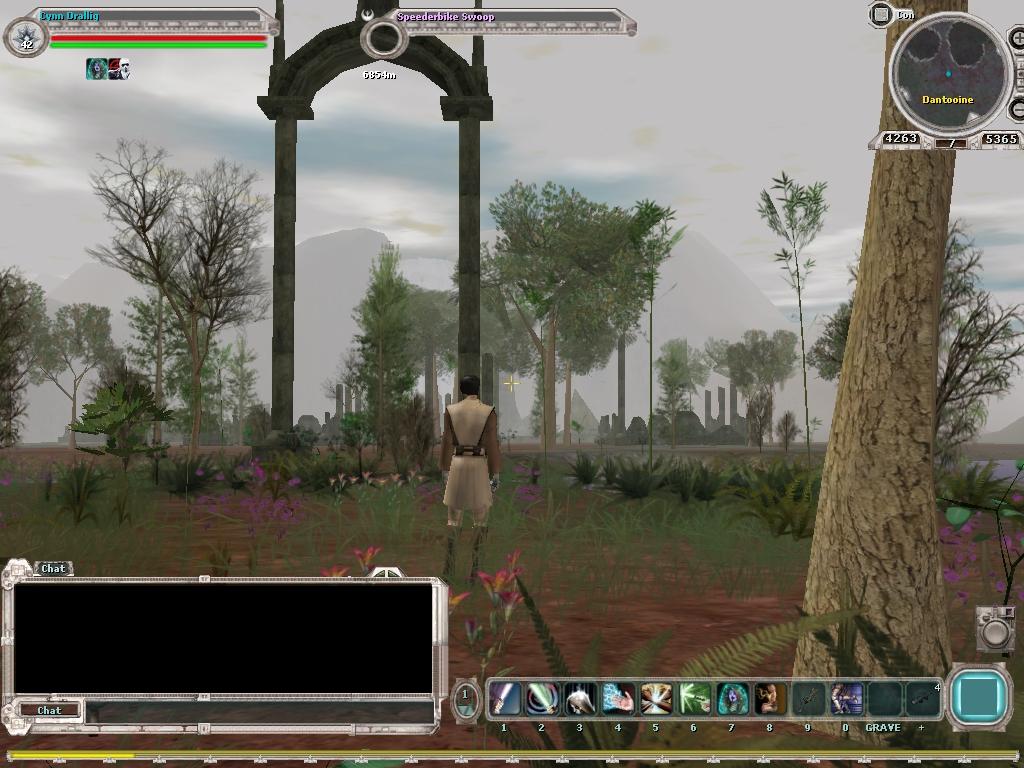
An example of the lush environment in Galaxies
The original basic "game world" consisted of ten simulated planetary surfaces and associated structures. The twelve different planets were taken from the Star Wars films and the Expanded Universe: Tatooine, Naboo, Corellia, Talus, Rori, Dantooine, Lok, Yavin 4, the forest moon of Endor and Dathomir. The game's first expansion, Jump to Lightspeed, added explorable space sectors for every original planet. Two additional space sectors were also included, Deep Space and the Kessel sector. The chapter 8 update also added the Nova Orion Station. In the second expansion, Rage of the Wookiees, the Wookiee planet Kashyyyk was added. In the third expansion, Trials of Obi-Wan added the planet Mustafar (the only planet without an explorable space sector). Examples of characters and points of interest that players could visit within the game included HK-47 (from Knights of the Old Republic and its sequel), R2-D2, C-3PO, their escape pod on Tatooine, the Naboo Royal Palace, the abandoned Rebel bases on Dantooine and Yavin IV, the notorious pirate Nym in his stronghold on Lok, Ewoks and rancors.
Each of the ten original planets were represented by approximately 225 square kilometers (15 km x 15 km) of game space, with all established cities and locations compressed into that space. In contrast, the expansion planets of Kashyyyk and Mustafar were smaller, constructed differently (e.g. instances) and in some cases imposed different rules than the original, such as terrain that was not traversable (i.e. mountains or hills that cannot be climbed over). Kashyyyk was represented by several navigational zones that connected to each other via portals located throughout that planet. Many of these zones were instanced, meaning that only the player or group that selected that zone were likely the only inhabitants of that zone. Mustafar had a traditional layout similar to the original planets, but with many instanced dungeons scattered across the landscape. With the release of Chapter 11, the planet Hoth was released as an instance. Ord Mantell was also added.
In basic gameplay, the player used his or her character's skills and special abilities to attack targets, complete quests, undertake missions, create useful in-game items, and/or entertain other players. The player's character would have opportunities to meet famous Star Wars characters, earn in-game fame and fortune (or infamy and notoriety), travel to iconic Star Wars locations, and obtain numerous items, artifacts, and "trophies" that could enhance his or her character.
Players of the game created characters to navigate through these environments. Characters in Star Wars Galaxies could be one of ten species, again taken from the films and the Expanded Universe: Human, Twi'lek, Zabrak, Wookiee, Trandoshan, Rodian, Mon Calamari, Bothan, Sullustan, or Ithorian. A character could be either male or female, and he or she belonged to one of nine iconic professions: Jedi, bounty hunter, smuggler, commando, spy, officer, medic, entertainer, or trader. Chapter 6 has introduced beast master, the NGE version of the pre-NGE creature handler, as a separate expertise tree. A character could also optionally advance in the politician and pilot professions, independent of his or her primary profession. As with all MMORPGs, the feature set of Star Wars Galaxies were subject to change.
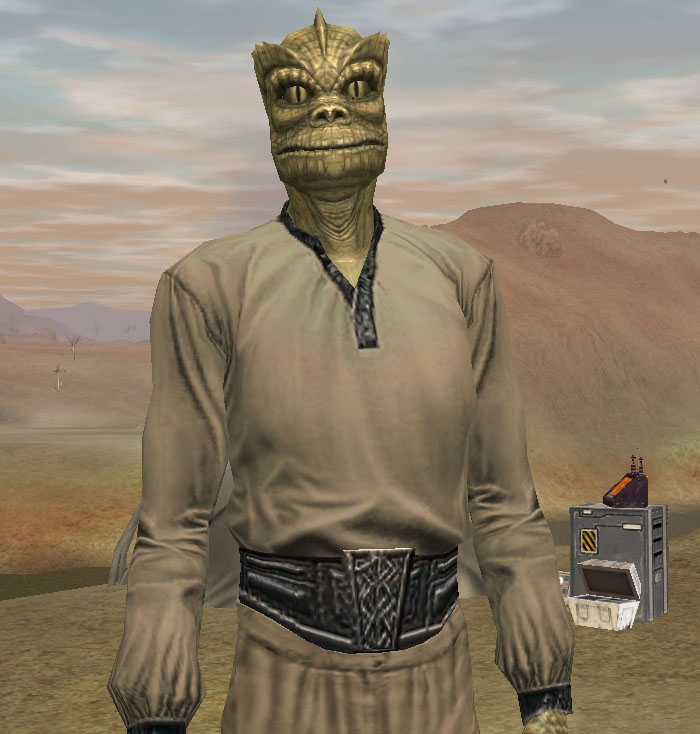
Trandoshan Balfur Jhcor
A player could create a male or female character of the following species:
There were a number of species that appeared throughout the game as NPCs (non-player characters).
- Feeorin
- Firrerreo
- Gamorrean
- Geonosian
- Gotal
- Gran
- Gungan
- Hutt
- Ishi Tib
- Jawa
- Kitonak
- Klatooinian
- Kowakian monkey-lizard
- Mustafarian
- Nautolan
- Neimoidian
- Nikto
- Ortolan
- Pa'lowick
- Quarren
- Selonian
- Talz
- Toydarian
- Tulgah
- Tusken Raider
- Weequay
- Whiphid
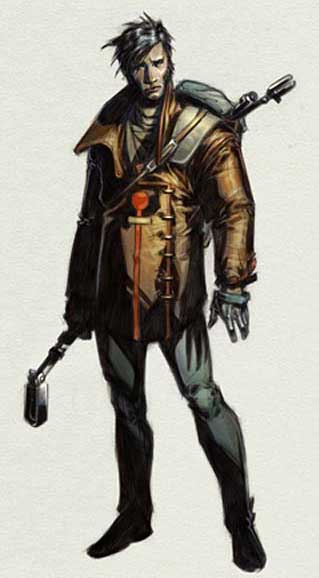
A male fringer
These professions were available in the game's later releases, following the "New Game Enhancements":
- Jedi
- Officer
- Smuggler
- Bounty hunter
- Commando
- Trader
- Medic
- Entertainer
- Spy
- Pilot
- Beast Master
- Chronicle Master
Characters could erect, own and decorate a variety of buildings, including houses, cantinas, guild halls and city halls. These buildings, when grouped, could be organized into cities. Players held elections via ballot box for Mayor. Elected mayors granted city members certain rights to place structures within the city and eject players from cities as needed. Reelections were held every three weeks. If another player wished to run for mayor, they could add their name at any time to the ballot box to run against the incumbent. As cities grew in population, they became eligible to add services and facilities such as vehicle repair garages, shuttleports, cloning facilities, hospitals, cantinas and garden displays. They could show up on the planetary maps alongside canonical cities such as Theed and Mos Eisley.
The game included a variety of playable and non-player controlled ships:
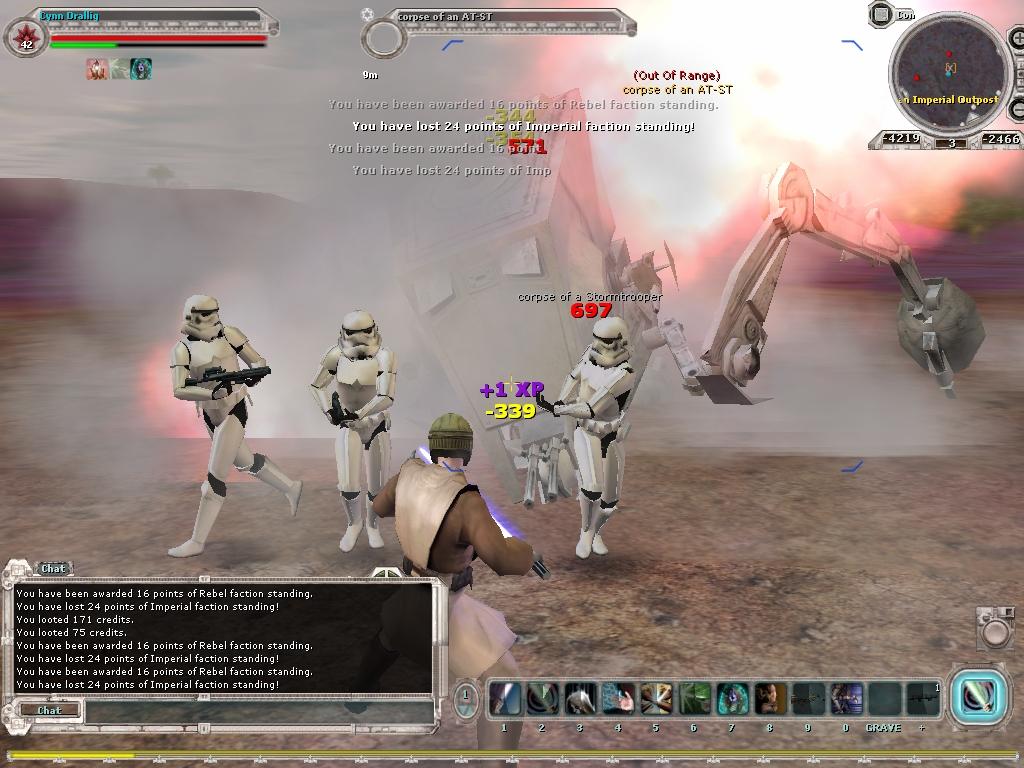
A Jedi fights Imperial troops in Galaxies.
- : Ground combat in Galaxies was in real time and similar to a first-person shooter. Unlike most MMORPGs, whether an attack hits was not solely based on the character's skill numbers. The player had to aim a targeting reticule at a target and left-click the mouse to fire. Auto-aim and auto-fire features were later made available, creating a more traditional combat experience, but players eschewing those options were rewarded with an increased chance to do maximum damage. As characters gained levels (by gaining experience points, known as XP), they gained access to additional combat abilities, called "specials," which were "fired" by using the right mouse button. These specials usually had a cool-down period during which they could not be reused, but they were much more powerful or versatile than the basic left-click attack. Specials were also used to heal characters and enhance their other abilities as well as decrease an enemy's statistics. In addition to these specials, players gained the ability to use more powerful and varied type of weaponry as they climbed the ranks in their chosen profession. For example, the KYD-21 blaster pistol was limited to the Spy profession.
- : Space combat in Galaxies was similar to ground combat. Players had to aim at their targets (often needing to "lead" their target to compensate for the target's movement) and click a button on the mouse or joystick to fire. Success in space combat was largely dependent on player skill, but not quite to the same extent as seen in previous Star Wars space-simulator games. As characters advanced in their piloting professions, they gained access to a variety of tactics, starship chassis, and starship components. Their ships could be completely customized with components looted from enemies or crafted by shipwrights. Available chassis included the X-wing and Y-wing for Rebels, TIE Fighters and TIE/IN interceptors for Imperials, and new Hutt and Black Sun ship designs for Freelancers. Characters who mastered a piloting profession got access to PoB (Party on Board) ship designs such as the famed YT-1300 light freighter. PoB ships allowed characters to walk around the interiors (which could be decorated just like a building on the ground) and man additional shipboard stations such as laser turrets. Some high-end ships were obtainable only via difficult quests; such ships include the Eta-2 Actis-class interceptor (commonly called the JSF or "Jedi Starfighter") and the KSE Firespray (made famous by the Fett ship Slave I).
- Single- and multi-passenger ground vehicles and starships (landspeeders, speeder bikes, swoops, X-wings, TIE Fighters and even several of the YT-series of ships).
- An almost completely player-run economy, wherein player characters were responsible for creating many (and nearly all) in-game items including blasters, starships, clothing, armor, food, housing, furniture and even a wide variety of droids. Items were created from player-collected raw materials and looted items—with other player characters as the only consumers. Later, the developers added more high-quality equipment to loot tables and as quest rewards, but player crafters remained an essential part of the economy.
- An extensive set of emotes, moods, and associated animations, which affected not only an avatar's physical appearance but also the text used to describe a character's speech, and even the shape of the speech bubble displayed on-screen.
- Standard MMORPG features such as player guilds, chat functionality, and other community features.
- The ability for players to place bounties on opponents that defeated/killed them in player-versus-player (PvP) battle. Player character bounty hunters could then pick up another character's "bounty mission" on the terminals and track the character down. A bounty could be claimed at any time, regardless of the target's PvP setting. Up to three bounty hunters could track a character at any given time.
- An extensive avatar/character-creation system. Characters could hire Entertainers to change their appearance in-game, with even more options than those available at creation. Every visual aspect of a character was thereby changeable at any time after character creation except species and gender.
There were twenty-five different servers—called "galaxies"—in which players could choose to play the game. Most of them were named after obscure ships from the Expanded Universe. Twelve were shut down on October 15, 2009, leaving thirteen, which were shut down with the game's closure on December 15th, 2011. They are:
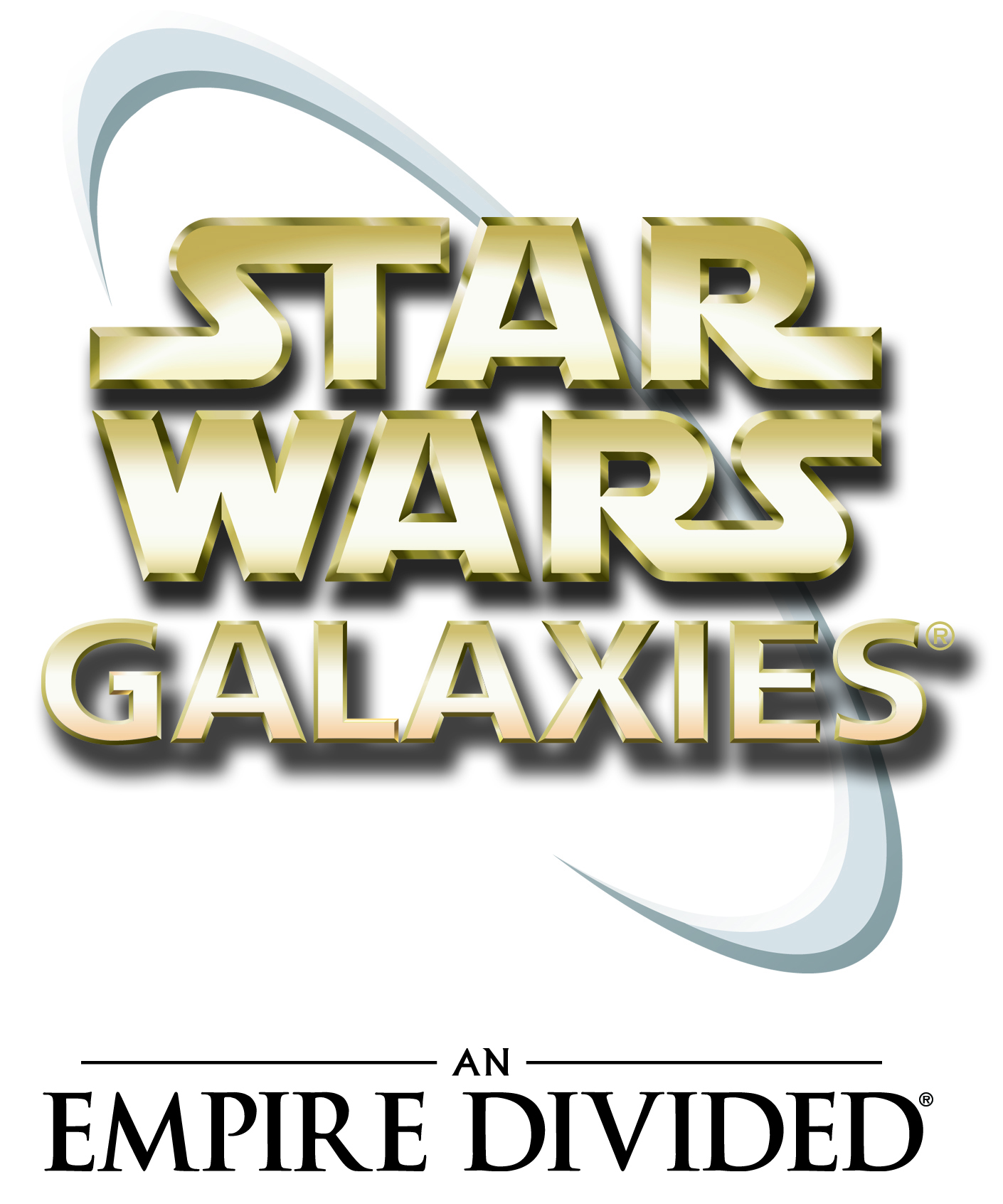
An Empire Divided logo
At the time of its initial release, the game was very different than it was at the time of its closure. Vehicles and creature mounts were not yet implemented. While player housing was in the game, player cities were not. (Those features were added in November 2003.) Each character and creature possessed three "pools" (called Health, Action, and Mind; or "HAM") that represented his or her physical and mental reserves. Most attacks specifically targeted one of these three pools, and any action the character took also depleted one or more of the pools. When any one of those pools was fully depleted, the character would fall unconscious. Combat required the player to carefully manage his or her actions to avoid depleting a pool.
Character progression was vastly different at release as well. Characters started out in one of six basic professions (Medic, Brawler, Marksman, Scout, Entertainer, or Artisan) and could pick up any of the other five at any time after character creation. Each profession consisted of a tree-like structure of skills, with a single Novice level, four independent branches of four levels each, and a Master level which required completion of all four branches. Characters purchased these skills with experience points gained through a related activity. For example, an Entertainer could purchase skills to get better at playing music, but only with Musician experience points. Dancing experience points were entirely separate and could only be used to purchase dancing skills.
In addition to the basic professions, characters could specialize into advanced professions such as Bounty Hunter, Creature Handler, Ranger, Doctor, and Musician. There were a total of 24 advanced professions, although there was no way for characters to obtain all of them at once. Each advanced profession had certain skill requirements from the base professions that had to be met, some more restrictive than others.
Jedi were not available as a starting profession, nor even as an advanced profession. The developers stated only that certain in-game actions would open up a Force-sensitive character slot. The actions required were left for players to discover. It eventually turned out that characters had to achieve Master level in five random professions. The identity of four of those necessary professions could be learned via looted holocrons, but the fifth had to be found via trial and error. The first Force-sensitive character slot was unlocked on November 7, 2003.
In addition to the base game, three expansions were developed by SOE and published by LucasArts since the game's inception:
The Combat Upgrade of April 2005 was a major revamping and rewriting of the entire Star Wars Galaxies combat, armor, and weapons system. A more restricted tone was set, whereas only certain characters in certain professions would use specific weapons and wear armor. In addition, the method of fighting in the game was redone with skill levels assigned to both players and game creatures. Under the new system, only a creature of equal skill could be attacked by a player, with lesser creatures rendering no experience if killed and the more powerful creatures deemed almost invincible to single player attacks.
On November 15, 2005, there was a complete overhaul of all game aspects, reducing the number of professions to nine, down from original thirty-two. New patches came out emphasizing the balance and individuality of each profession. These included:
Beginning January 13, 2009, SOE began offering a free character transfer to all current subscribers of the game. Players were allowed a one-time only transfer from one "galaxy" (or server) to another. The departing and destination servers were each part of separate lists. You could only depart from a set list of servers and could only transfer to a set list of servers. This promotion was set to end on October 15, 2009.
SOE announced on September 15, 2009 that a number of Star Wars Galaxies servers would be permanently shut down on October 15th, 2009. The following is a list of the servers that were permanently closed on this date. All characters, items, and structures still present on those servers were permanently lost when they closed down.
- Corbantis
- Europe-Infinity
- Intrepid
- Kauri
- Kettemoor
- Lowca
- Naritus
- Scylla
- Tarquinas
- Tempest
- Valcyn
- Wanderhome
SOE later announced that, beginning on October 16, 2009, players who had had characters on the deactivated servers, yet did not take advantage of the free character transfer service, could contact SOE Customer Support and, for the standard $50.00 USD charge for a Character Transfer, could transfer a character from an inactive server to an active one. However, as a courtesy, when some users submitted their requests to the GMs, the transfer fee was waived.
Sony announced on April 20, 2011 that they would begin offering free, unlimited character transfers between servers on April 26, 2011. When this system became active, the paid service was no longer available, though many of the same restrictions as on the paid service still applied. Additionally, under this new system, players were unable to transfer to the Starsider server; however, they could transfer from the server and could also transfer between other servers every 90 days.
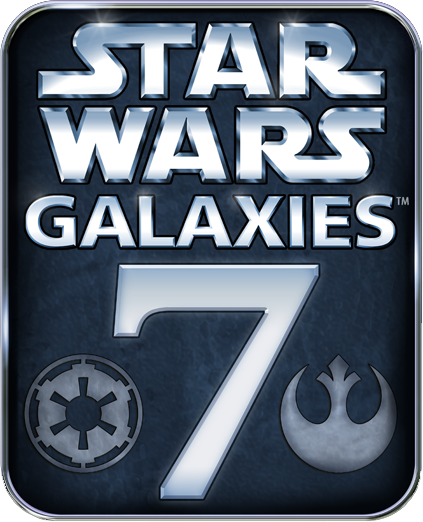
The official seventh-anniversary logo for the game.
- June 26, 2003: Star Wars Galaxies: An Empire Divided (initial boxed release) and Star Wars Galaxies: An Empire Divided Collectors Edition
- October 27, 2004: Star Wars Galaxies: Jump to Lightspeed (boxed expansion)
- April 27, 2005: Combat Upgrade (free major online revamp)
- May 5, 2005: Star Wars Galaxies: Rage of the Wookiees (digital download expansion)
- May 25, 2005: Star Wars Galaxies: The Total Experience (boxed compilation of An Empire Divided, Jump to Lightspeed, Rage of the Wookiees)
- November 1, 2005: Star Wars Galaxies: Trials of Obi-Wan (digital download expansion)
- November 15, 2005: New Game Enhancements (free major online revamp)
- November 22, 2005: Star Wars Galaxies: Starter Kit (boxed compilation of An Empire Divided, Jump to Lightspeed, New Game Enhancements)
- November 16, 2006, Star Wars Galaxies: The Complete Online Adventures (boxed compilation of An Empire Divided, Jump to Lightspeed, Rage of the Wookiees, Trials of Obi-Wan and New Game Enhancements)
- September 28, 2007, Star Wars Galaxies: The Complete Online Adventures (digital compilation of An Empire Divided, Jump to Lightspeed, Rage of the Wookiees, Trials of Obi-Wan and New Game Enhancements)
- September 28, 2007, Star Wars Galaxies: The Complete Online Adventures (premium digital compilation of An Empire Divided, Jump to Lightspeed, Rage of the Wookiees, Trials of Obi-Wan, New Game Enhancements with an additional in-game J-type 327 Nubian royal starship instant travel vehicle)
- November 20, 2009, Star Wars Galaxies: The Complete Online Adventures (premium plus pack digital compilation of An Empire Divided, Jump to Lightspeed, Rage of the Wookiees, Trials of Obi-Wan, New Game Enhancements with additional in-game rewards: J-type 327 Nubian royal starship instant travel vehicle, Tsmeu-6 personal wheel bike, All Terrain Recon Transport, Mustafarian Underground Bunker, Varactyl and Lava flea mounts)
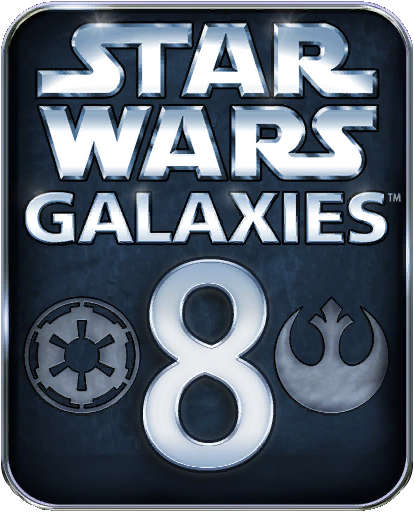
The official eigth-anniversary logo for the game.
On June 24, 2011, SOE announced that Star Wars Galaxies and the Star Wars Galaxies Trading Card Game would permanently shut down on December 15, 2011, primarily due to Star Wars: The Old Republic effectively replacing it. Additionally, the ability to purchase cards and booster packs for the trading card game was disabled. Starting September 15, 2011, the game became unavailable for purchase at retail or through digital download, and no new or reactivated accounts were allowed after this date. Additionally, all billing for the game was turned off on this date; any accounts that were active and in good standing at the time were able to play the game for the remainder of time for free, and any such accounts were able to try any SOE game for free as a full member. After the shutdown, some former players created servers that emulate the pre-CU and NGE version of the game.
Prior to its launch, Galaxies won E³ Awards for two years in a row, first in 2001 for Best PC Game and Best Online Multiplayer, and then in 2002 for Best Online Multiplayer.
Reviews for the initial launch of the game in 2003 were mostly positive. The game was praised for its lush graphics, liberal use of the film soundtracks, massive world size, character customization, creative creature ecology, complex skill system, player economy interdependencies and its sandbox approach. Reviewers criticized the overwhelming complexity of the game, PvP/PVE combat imbalances of the professions, bugginess and lack of quest content. The reviews for the first expansion, Jump To Lightspeed, praised the new space combat but criticized the ground game for its lack of sufficient improvement. The reviews for the second expansion, Rage Of The Wookiees, lauded the new quest content for current subscribers but lamented the Combat Upgrade and the continued bugginess of the game. The third expansion, Trials Of Obi-Wan, once again introduced new quest and content and the planet Mustafar. However, two weeks later a new system called NGE was introduced, which forever changed the play style of Star Wars Galaxies and removed some of the content that was included with Trials Of Obi-Wan.
Franchise creator George Lucas revealed later to the developers of The Old Republic that he was "a big fan" of Galaxies and that his son Jett loved playing the game as well.
Players who wished to play a Jedi character had to first unlock their Jedi slot by fulfilling an unknown list of criteria. However, within four months of this stipulation, no player had yet achieved the goal. The Jedi forum at the official site turned into a "flamer's paradise" as some subscribers accused the developers of lying about the Jedi system being in place. The first player unlocked their Jedi slot on Friday November 7, 2003. LucasArts game producer Haden Blackman stated in an interview on December 20, 2003, with Gamespy: "We're confident in the [Jedi] system because the feedback from players has been extremely positive. Not only are Jedi players happy with the system and the powers they are receiving…." This caused a backlash by some players who felt this statement was misleading. Gamespy noted: "GameSpy's mail was so flooded with reports from the Galaxies community that we started researching this feature to present both sides of the story." Because the time commitment to unlock a Jedi was substantial, players complained that perma-death of the character after three deaths was overly harsh. The developers eventually relented and lowered the penalty to skill loss in January 2004.
Some players further complained that the process of unlocking the Jedi slot, known as "hologrinding," was overly long, painful and disruptive to the social fabric of the game. In March 2005, the developers released a quest system as the new path to unlocking the Jedi slot. With the NGE (see below) in November 2005, allowing all players, including new ones, to play a Jedi character, there were complaints that the time and effort that veteran players had expended in unlocking their Jedi slots were all for naught.
SWG developers promised a "Combat Upgrade" or "CU," which was released April 27, 2005, and represented a major rewrite of the combat, armor, and weapons systems, wherein only certain professions could use specific weapons and armor. The combat mechanics in the game were shifted from a skill system to a combat-level system for both players and game creatures. The icon graphics were changed from monochromatic to color. This alteration resulted in controversy caused by players who criticized the changes, and cancellations during that time.
Another set of game changes dubbed the "New Game Enhancements" (NGE) began testing on November 4, 2005, going live on November 15 via digital download, and became available in retail as the Star Wars Galaxies: Starter Kit on November 22. Changes included the reduction of the 34 original professions to nine "iconic" ones. There were criticisms of the changes in some reviews, and negative player feedback was noted by media outlets outside the gaming industry, including CBS News, New York Times, New York Post and Wired Magazine. On Slashdot, president of SOE John Smedley explained that they felt it necessary to revamp the game to the NGE in order to reverse the deterioration they were seeing in the subscriber base. The development team affirmed this was their desired direction for the game, and they were slowly modifying parameters to address players' desires. This progress included the re-introduction of some pre-NGE features that were removed, such as creature handling, target locking, auto-firing, the ability to fire special attacks from their keys, and the option to keep the camera behind the character, rather than the NGE's over-the-shoulder perspective. The development team also gave each profession a set of "Expertise trees" to bring back some complexity and differentiation to characters. Thousands of players canceled their accounts as a result of the NGE. In a 2014 reddit chat, Smedley wrote that he "would do everything differently" if given a chance to relaunch the game, and that SOE's next project would please players of Star Wars Galaxies.
The Trials of Obi-Wan expansion met with controversy as, two days after the expansion was released, the development team announced the NGE. Many players objected that they would not have purchased the expansion if they had known in advance about the NGE. SOE eventually offered a refund to players who had purchased the expansion prior to the NGE, though this offer was quickly rescinded due to what the player community believed was an overwhelming number of refund requests.
Many industry professionals expected that the subscription numbers would exceed the one million mark, a feat accomplished only thus far in Asia by MMORPGs such as Lineage and more recently by World of Warcraft. Based on NPD figures as of February 2004, Star Wars Galaxies sold more than 300,000 boxed copies at retail for a total initial revenue of over $18 million dollars. SOE confirmed in March 2004 that there were well over 200,000 monthly subscribers, making it the second-largest MMORPG in North America. The company later reported in 2004 that they had 250,000 subscribers. In August 2005, SOE reported that they had now sold 1,000,000 boxed copies of the game. Media sources reported that the subscriber numbers had fallen substantially since the release of the CU and the NGE. In early 2006 after the NGE, allegedly "hacked" numbers purported to show that only 10,363 subscribers were playing on a particular Friday night. The President of SOE, John Smedley, denied that subscriptions had fallen this low: "Have the numbers in Star Wars Galaxies gone down? I will tell you that the concurrent numbers have gone down. Are they as low as what was shown there? Absolutely not."
As of the second quarter of 2006, according to charts at MMOGchart.com, there were estimated to be between 110,000 and 175,000 subscribers. However, even MMOGchart.com rated the subscriber number as a "C," which means they are "merely industry 'best guesses' or are otherwise questionable" due to SOE not releasing SWG subscriber numbers.
When Leland Chee was asked on the StarWars.com Message Boards if Star Wars Galaxies was generally ignored when it came to canon, since reclassified as Star Wars Legends, he replied:
When asked about player-created characters, ships, and events featured on the official Star Wars Galaxies website, Leland stated that such aspects of the game were:
The game developers drew many aspects of the films and Expanded Universe. However, in some cases, they do not fit into the era. Keeping in mind that the time frame of this game was meant to be shortly after the Battle of Yavin (0 ABY–1 ABY), some elements of the game arguably should not be there:
- The opportunity to play as a transcended Force ghost Jedi character. This option was only accessible by those players who attained Jedi status prior to the NGE.
- Jedi could be seen in large numbers in many major cities, equipped with Jedi robes and ignited lightsabers. Also, Jedi were dominant combatants in the Galactic Civil War (see below).
- Players using non-Human characters could earn military ranks in the Empire, resulting in Imperial Wookiee generals and the like.
- The ability of players to craft and pilot ships such as the B-wing and A-wing, which supposedly were not designed yet.
- Chapter 5 introduced combat droids for regular use, which are highly uncommon for this era.
- Large quantities of buildings dotted about landscapes that wouldn't normally be populated, such as Tatooine.
- The ability of players to craft and equip Mandalorian armor, which became quite abundant as time went by.
- Cloning was outlawed during the Galactic Civil War, and so massive cloning centers on every planet would be breaking the laws of the Empire.
- Clones in the Star Wars universe took up to ten years to grow and mature even when they were biologically engineered to age faster than normal. In Star Wars Galaxies, it was the option of the player to clone his character instantly in a cloning center whenever he dies. However, this may have been a mere game mechanic to allow for quicker play.
- The rancor is identified as an crustacean/arachnid hybrid, though it displays the traits of neither and has already been identified in more reliable sources as a reptomammal.
- Game Update 11 introduced the Galactic Marine armor for Imperial players. The armor itself was not in frequent use at the time of the Galactic Civil War.
- Game Update 12 introduced more battle droids such as B2 super battle droids, MagnaGuards, and DSD1 dwarf spider droids. These, as well as the battle droids introduced in Chapter 5, are highly uncommon during this era.
In few of the above cases, the developers provided a reasonable in-universe explanation of these elements' existence. However, it is unknown if other sources will accept them as canon.
The game focused more on allowing its players to experience as many facets of Star Wars lore as possible, sometimes at the expense of consistency inside its own universe (for example, the mayor of Mos Eisley highlighted the incident in the cantina when Obi-Wan revealed himself as Jedi as something special, even though Jedi were a common part of the game population).
Unlike the historic chronology of Star Wars, where almost all Jedi are extinct by the time frame of Star Wars: Episode IV A New Hope, Star Wars Galaxies allows for hundreds or thousands of Jedi playing in the game, which is set in the period of time between the first film and Star Wars: Episode V The Empire Strikes Back.
Under the original Jedi system, a player could only become a Jedi after mastering professions chosen randomly at character creation. When fewer Jedi entered the game than was anticipated, players were helped by finding several holocrons, which would tell a player which game professions to play and master. This resulted in several "career" players spending hours on end writing program macros and mastering almost every profession in the game. However, after complaints from a large portion of the player base (especially those that weren't constant and devoted players and thus less willing to master multiple professions), Star Wars Galaxies was given a new Jedi system called the Jedi Trials. Under the Jedi Trials, only after obtaining various goals as a regular character was a character considered "glowing with the Force" and deemed worthy to train to become a Jedi. Several new tasks then became available to the player, which were revealed through various non-player characters. Such tasks included obtaining skills, destroying creatures, and visiting several Jedi-related locations. Even with the Jedi revamp in place, many in the Star Wars Galaxies community expressed feelings that the game would become an "Army of Generals" where the number of Jedi playing in the game will be extremely high, thus making the game less interesting for those playing non-Jedi characters. The method of obtaining Jedi skills was changed considerably under the "Combat Upgrade" system released in April 2005.
After the NGE, anyone could become a Jedi by selecting the "profession" when creating their character. Arguments came up proposing that Jedi, once the NGE was released, would still be unbalanced, only this time with the odds against them. Many Jedi came into the NGE and saw that their former power was dramatically reduced. At one point, the village of Aurilia (the in-game location that served as a hub for pre-NGE Force-sensitive questing) became inactive. Players that were still inside when this happened found only a few NPCs left. Some players still wished to see the village reopened as a sort of training center for the Jedi made to ensure the old prizes don't disappear from the game. But it was later announced that Aurilia would never be returned to its former state, and was re-opened in a different form; in Chapter 7, it became the location where a player could receive quests, which, upon completion, will allow the player to access the "heroic instances," which were battles against multiple "bosses," with puzzle and strategy elements mixed in. These heroics were designed to be completed with a group of players, usually eight.
- Star Wars Galaxies: The Ruins of Dantooine - A tie-in novel to Star Wars Galaxies which was co-written by W. Haden Blackman and Voronica Whitney-Robinson. It was published by Del Rey on December 30th, 2003.
- Star Wars Galaxies Trading Card Game: An online card game that was launched in August 2008 and was available to all Galaxies subscribers. Its initial release was called Champions of the Force. Several expansions were released since its inception. It allows players to play on their own or against each other, in a new storyline that features Namman Cha, Rachi Sitra, Jeffren Brek and Coret Bhan in their quest for the Codex of Tython. It also features special loot cards that could be redeemed for in-game items in Galaxies.
- The Story of General Grievous: Lord of War
- Underworld Appendix: Swoops, Spice, and Wretched Rogues
- Star Wars: Empire at War
- Star Wars: Knights of the Old Republic: Days of Fear
- The Complete Star Wars Encyclopedia
- Planet Design: Building Worlds